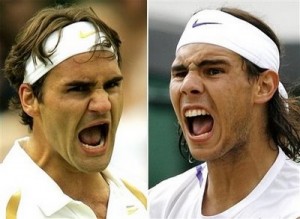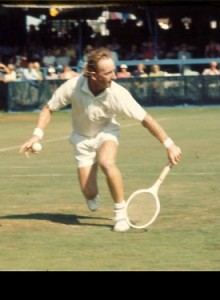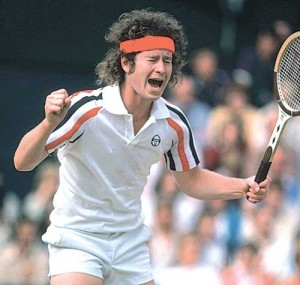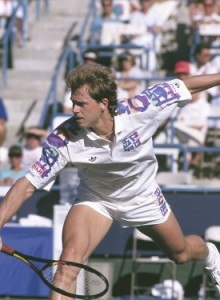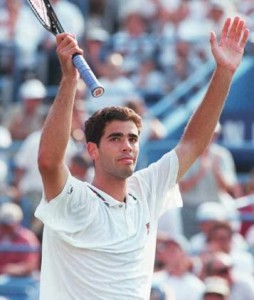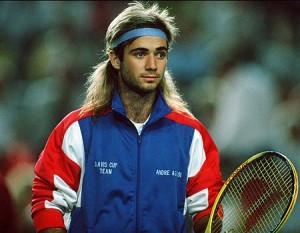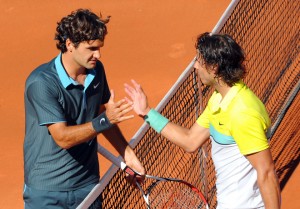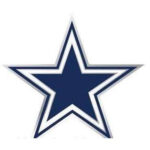Will Federer and Nadal Continue To Dominate at Tennis Grand Slams?
By now tennis fans are so used to the status quo that anytime Roger Federer or Rafael Nadal does not win a slam, the airwaves crackle with speculation.
Since 2003 Roger Federer has won 16 slam titles. The Swiss began with one title in 2003 at Wimbledon and ended with one title in 2010 at Melbourne, averaging almost three a year in the intervening years.
The news is usually when Federer is NOT in a grand slam final. He has won four Australian Open titles, one French Open championship, six titles at Wimbledon and five consecutive titles at the U.S. Open from 2004-2008. He had appeared in 23 consecutive semifinals until Robin Soderling stopped that record at the French Open in 2010 during the quarterfinals.
Twenty-four year-old Rafael Nadal who won his first French Open title in 2005 has now won five titles at Stade Roland Garros. In 2010 Nadal captured a career grand slam when he won the U.S. Open for the first time.
In addition to five French Open titles and one U.S. Open championship, Nadal has captured Wimbledon twice in 2008 and 2010 and the Australian Open once in 2009. Nadal owns nine grand slam trophies.
That leaves little room for anyone else. This iron grip on majors is quite unusual in the history of the sport. True, other players have dominated, but not for such an extended period. If we look back at the years since the Open Era began, you begin to see how extraordinary the dominance of the current No. 1 and No. 2 ranked players has been.
Open Era: 1969-1974 – The Aussie Years
1969 marked the first full year of competition in the Open Era.
Once all players, amateurs and professionals, began to compete in the four grand slams, major tournament landscapes definitely changed.
All the best players took part. In the six years between 1969-1974, ten different players won 24 major titles with most surfaces grass covered except the French Open, played on clay.
The wave of Australians continued to dominate men’s tennis during the early stages of the Open Era.
Australian Rod Laver started things off by winning a grand slam in 1969, capturing each major in that calendar year.
His four wins in 1969, however, were Laver’s only major championships in the Open Era, although Laver is credited with 11 slams overall.
Countryman John Newcombe also won 4 slam titles during the years 1969-1974. The Aussie won two Wimbledon titles in 1970-1971. In 1973 Newcombe won the Australian and U.S. Opens.
Another Aussie stepped up to win three majors as Ken Rosewall won the U.S. Open in 1970 and the Australian Open in 1971 and 1972.
Czech Jan Kodes, during this same time period, won three major titles––two French titles in 1970 and 1971 and the Wimbledon crown in 1972.
American Jimmy Connors also scooped up three titles in 1974 at the Australian Open, Wimbledon and the U.S. Open––three grass court tournaments.
The other multiple slam winners during this 6-year window were Romanian Ilie Nastase who won the U.S. Open in 1972 and the French Open in 1973 plus American Stan Smith who won the U.S. Open in 1971 and Wimbledon in 1972.
Other single winners during this period were American Arthur Ashe who took the Australian Open in 1970, Spaniard Andres Gimeno who won the French Open in 1972 and Swede Bjorn Borg who won his first major, the French Open in 1974.
Ten men in all won 24 major titles in the first 6-year period of the Open Era. [+2.4]
Open Era: 1975-1980 – The Swedish Phenom Era
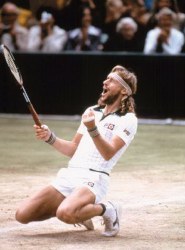
Swede Bjorn Borg captured the heart and soul of tennis viewing public, winning 6 French Opens and 5 Wimbledons.
No one impacted tennis more significantly during these early years of the Open Era than the teenager from Sweden, Bjorn Borg.
The Swede won nine slam titles in this tiny window and cemented his place in tennis annals.
In all Borg won 11 titles in eight years.
In total, 12 different players won slams from 1975-1980, noting that the Australian Open had two champions in 1977 because of a change of the tournament schedule.
There were 25 slams played instead of the normal 24.
Swede Bjorn Borg won four French titles in 1975, 1978, 1979, and 1980 as well as five consecutive Wimbledon titles in 1976, 1977, 1978, 1979 and 1980.
Argentine Guillermo Vilas won four titles––the French Open and the U.S. Open in 1977 and the Australian Open in 1978 and 1979.
American Jimmy Connors won the U.S. Open twice, in 1976 and 1978, once on clay and once on Deco Turf, while fellow American John McEnroe won the U.S. Open in 1979 and 1980.
All other winners who captured one title during this time period included Arthur Ashe who took the Wimbledon crown in 1975, Italian Adriano Panatta who won the French Open in 1976 as well as Spaniard Manuel Orantes who won the U.S. Open in 1975.
At the Australian Open, John Newcombe won in 1975, fellow Aussie Mark Edmondson won in 1976 and American Brian Teacher followed winning in 1980. Americans Roscoe Tanner and Vitas Gerulaitis won the Australian Open in December of 1977 and in January of 1977, respectively.
Twelve men were winners at 25 slam championships. [+2.08]
Open Era: 1981-1986 The Rise and Fall of John McEnroe
Some new dominant players were beginning to build their careers enjoying success at the majors.
John McEnroe finally overcame Bjorn Borg, climbing into the spotlight where he dominated for a time before the inevitable decline.
In this 6-year period, nine different players won majors keeping in mind that there was no Australian Open played in 1986 as the Aussies shifted their calendar again.
American John McEnroe won five titles––three Wimbledon wins, including the historic defeat of Borg in 1981, followed by victories in 1983 and 1984. The American also captured two U.S. Opens in 1981 and 1984.
Newcomer Swede Mats Wilander shocked the world by winning his first French Open title at age 17 in 1982. He won another in 1985 as well as two Australian Open titles in 1983 and 1984––four titles in all. All assumed Wilander was the second coming of Borg.
Also battling it out for supremacy at the majors was Czech Ivan Lendl who finally won the French Open in 1984 and 1986 as well as the U.S. Open in 1985 and 1986. Lendl captured four titles in total during this time period.
Scrambling to the top again was American Jimmy Connors who took home three titles–– winning Wimbledon in 1982 and capturing two U.S. Open trophies in 1982 and 1983.
South African Johan Kriek won the Australian Open in 1981 and 1982 while newcomer German Boris Becker stormed into Wimbledon winning it in 1985 and 1986.
The singular winners were significant in their own right. Swede Bjorn Borg won the French Open in 1981, his last slam victory. Borg walked away from tennis at age 25 after losing the 2001 U.S. Open to John McEnroe.
Frenchman Yannick Noah won the French Open in 1983 defeating Mats Wilander and igniting the French crowd who could finally celebrate a home-grown champion.
Newcomer Stefan Edberg won the Australian Open in 1985, his first slam victory in an illustrious career.
Only nine men walked away champions in 23 slam finals. [+2.55]
Open Era: 1987-1992 – The Beginning of the End of Traditional Serve and Volley
As McEnroe and Connors faded, traditional serve and volley emerged in the games of Boris Becker and Stefan Edberg. It also flashed as Aussie Pat Cash stole his moment on Centre Court.
On the other hand, Ivan Lendl had re-established baseline, power tennis. Many would follow his style of play and adapt it to their own particular strengths.
From 1987-1992 eleven men won majors with one tournament played on grass at Wimbledon, one on clay at Stade Roland Garros, and two on hard courts with the Australian Open establishing hard courts at Melbourne Park in 1988.
The U.S. Open had switched to hard courts in 1978. 1987 was the last year the Australian Open was played on grass.
Swede Stefan Edberg won five majors––the 1987 Australian Open, Wimbledon in 1988 and 1990 plus the U.S. Open in 1991 and 1992.
Ivan Lendl won four more slams––in 1987 the French and U.S. Opens as well as the Australian Open in 1989 and 1990.
Winning three slam titles in 1988, Mats Wilander won the Australian Open, the French Open and the U.S. Open, missing only Wimbledon that year.
Wilander was joined by Boris Becker who won Wimbledon and the U.S. Open in 1989 and the Australian Open in 1991. Jim Courier also won three, winning back to back French Opens in 1991-1992 and the Australian Open in 1992.
The remaining six winners won only once in this time period. Aussie Pat Cash captured Wimbledon in 1987 while Michael Chang captured his only major, the French Open in 1989, denying Lendl his last French trophy.
Ecuadorian Andres Gomez won the French Open in 1990. Newcomer American teenager Pete Sampras won his first title, the U.S. Open in 1990. German Michael Stitch won the Wimbledon crown in 1991 while American Andre Agassi won his first title at Wimbledon in 1992.
Eleven men became slam champions in 24 slam finals. [+2.18]
Open Era: 1993-1998 – The Rise of Pete Sampras
12 men won major championships from 1993-1998.
But no one won more or dominated more finals than American Pete Sampras who won ten slams during this time period.
Sampras ruled winning Wimbledon in 1993, 1994, 1995, 1997, 1998, the U.S. Open in 1993, 1995 and 1996 plus the Australian Open in 1994 and 1997.
The French Open forever eluded the American champion.
During this 6-year span Spain’s Sergi Bruguera won the French Open in 1993 and 1994. Andre Agassi won the U.S. Open in 1994 and the Australian Open in 1995. While Aussie Patrick Rafter took the U.S. Open championships in 1997 and 1998.
There were many new faces among those men winning for the first time and for many, the only time in their careers. The established players like Jim Courier won 1 title at the 1993 Australian Open. Boris Becker won one more Australian Open in 1996.
First-timer Austrian Thomas Muster won the French Open in 1995, followed by another first-timer Russian Yevgeny Kafelnikov who won the French in 1996. Richard Krajicek of the Netherlands won Wimbledon in 1996 while Brazilian Gustavo Kuerten announced his arrival by winning the French Open for the first time in 1997.
Czech Petr Korda won his only slam when he captured the Australian Open in 1998 followed by Spain’s Carlos Moya winning the French title in 1998.
12 men in all won 24 major titles in the fifth 6-year period of the Open Era. [+2.0]
Open Era: 1999-2004: Agassi’s Return to Power as a Swiss Star Rises
With numerous single winners populating the winner’s circle from 1999-2004, the number of slam champions soared to 13.
Pete Sampras was nearing the end of his great career as Andre Agassi continued to breathe life into his second coming.
A great deal of potential seemed to be emerging but no one individual player stepped forward to seize consecutive championships until Roger Federer battled his way to the top in 2003.
Andre Agassi won five championships during this time period including the elusive French Open plus the U.S. Open in 1999. Agassi also won the Australian Open in 2000, 2001 and 2003. Melbourne loved the man from Las Vegas.
Roger Federer won his first four major championships after struggling to get there. The Swiss realized his first win at Wimbledon in 2003, followed by three in 2004 at the Australian Open, Wimbledon and the U.S. Open.
Pete Sampras held on to win Wimbledon in 1999 and 2000 with his final slam championship coming at the 2002 U.S. Open, giving the American 14 grand slam titles in all.
Gustavo Kuerten came back to win the French twice more in 2000 and 2001 while new comer Aussie Lleyton Hewitt captured the U.S. Open in 2001 and Wimbledon in 2002.
Yevgeny Kafelnikov won the Australian Open in 1999 while his countryman Russian Marat Safin would win his first slam at the U.S. Open in 2000.
Croat Goran Ivanisevic won Wimbledon in 2001 while Sweden’s Thomas Johansson won the Australian Open in 2002. Spain’s Albert Costa won the 2002 French Open.
Spaniard Juan Carlos Ferrero took home the French crown in 2003 while Andy Roddick captured the 2003 U.S. Open. Argentine Gaston Gaudio won the 2004 French Open.
13 men in all won 24 major titles in this 6-year period of the Open Era. [+1.85]
Open Era: 2005-2010 Federer-Nadal Domination
In the last 6 years, covering 24 major finals, only five men have been crowned champions.
That is the lowest total recorded in the modern era by a wide margin.
Roger Federer has won 12, half of them, on his own: (3) Australian Opens in 2006, 2007, 2010; (1) French Open in 2009; (4) Wimbledons in 2005, 2006, 2007, 2009; and (4) U.S. Opens in 2005, 2006, 2007, 2008.
During this same 6-year period, Rafael Nadal has won 9 titles: (1) Australian Open in 2009; (5) French Opens in 2005, 2006, 2007, 2008, 2010; (2) Wimbledons in 2008 and 2010; and (1) U.S. Open 2010.
It took Nadal three years before he managed to break through the Federer juggernaut at Wimbledon, taking the title from Federer in a match many characterize as the best tennis match ever at the All England Club in 2008.
The Majorcan finally won on hard courts at the Australian Open in 2009. In 2010 Nadal won all the majors except the Australian Open which Federer won defeating Andy Murray in straight sets.
Other than the dynamic duo, three other men won championships: Marat Safin won the Australian Open in 2005. Novak Djokovic won the Australian Open in 2008 and Juan Martin del Potro won the U.S. Open in 2009.
Together, Federer and Nadal won 87.5 percent of the majors in this significant 6-year cycle with Federer winning 50 percent on his own and Nadal coming on at 37.5 percent.
Five men in all won 24 major titles in the seventh and most recent 6-year period of the Open Era. [4.8]
This makes the Federer-Nadal dominance the most significant in the history of the game.
Slam Winners: Putting the Numbers in Perspective
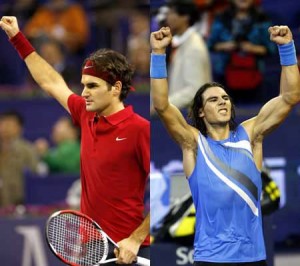 Ranked by winning ratio, here are the top men’s single slam winners for those claiming seven championships or more in the Open Era:
Ranked by winning ratio, here are the top men’s single slam winners for those claiming seven championships or more in the Open Era:
- Roger Federer (+2.0) 16 slam titles in 8 years, 2003-2010.
- Rafael Nadal (+1.5) 9 slam titles in 6 years, 2005-2010.
- Bjorn Borg (+1.375) 11 slam titles in 8 years, 1974-1981.
- John McEnroe (+1.17) 7 titles in 6 years, 1979-1984.
- Ivan Lendl (+1.14) 8 titles in 7 years, 1984-1990.
- Pete Sampras (+1.08) 14 titles in 13 years, 1990-2002.
- Mats Wilander (+1.0) 7 titles in 7 years, 1982-1988.
- Jimmy Connors (+.8) 8 titles in 10 years, 1974-1983.
- Andre Agassi (+.7) 8 titles in 11 years, 1992-2003.
Roger Federer leads the pack so far but nearing age 30, the question remains. Will he continue to add to his slam totals or can Nadal catch him and perhaps pass him? Nadal is only 24 years of age and appears to be performing at his peak.
Can anyone else break through and win a major in 2011?
Stay tuned in in 2011 and see what new surprises await…
